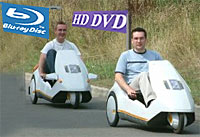 Toshiba has today released the first HD-DVD player.
Toshiba has today released the first HD-DVD player.
The Japanese release will be a big PR boost for the HD-DVD camp in their long running battle for the next-gen High Definition DVD format with Blu-ray. Toshiba said they plan to release the HD-DVD player in the US by the middle of next month and computers equiped with HD-DVD in April-June this year.
It will retail for 110,000 yen ($934, £539, E772) and Toshiba are hoping to sell 600,000 to 700,000 of the new machines globally in the fiscal year ending in March 2007.
As we’ve all learned, it’s not just the hardware that is important, it’s the amount of content available. Toshiba said they expected to have 150-200 films available in the format by December.
The next-gen DVD players offer considerably larger levels of storage, needed because High Definition video content is much higher resolution, therefore bit-hungry. They are also taking the opportunity to store lots more content on them, in an attempt to add value. The current DVD format does not have enough storage available to hold a feature film.
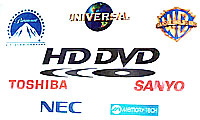 Where the Toshiba-lead HD-DVD will win with the public is in the simple extension of the DVD name, incorporating HD which everyone either does know about, or will do after the advertising frenzy around this years World Cup.
Where the Toshiba-lead HD-DVD will win with the public is in the simple extension of the DVD name, incorporating HD which everyone either does know about, or will do after the advertising frenzy around this years World Cup.
The battle between the two formats has astounded many people, many of whom simply throw their eyes to the ceiling wondering how Sony could re-live the VHS vs Betamax headache for them. It’s quite clear that Sony and their partners are determined not to loose this argument, apparently at any cost.
Sony, who have been selling Blu-ray equipment in Japan since 2003, plan to start selling their next-gen player, Blu-ray in the USA starting in July with a price of around $1,000.
 If you thought the switchover to digital television was going to be a challenge, spare a thought for the regulators, policy makers and engineers who are already tasked with trying to figure out the best way of re-allocating the spectrum freed up by switching off the analogue broadcasting signal.
If you thought the switchover to digital television was going to be a challenge, spare a thought for the regulators, policy makers and engineers who are already tasked with trying to figure out the best way of re-allocating the spectrum freed up by switching off the analogue broadcasting signal. The first two sessions focused mainly on the problems associated with harmonisation. It is essential that adjoining states will have to work together to allocate spectrum, if there are not to be interference issues. The ITU’s
The first two sessions focused mainly on the problems associated with harmonisation. It is essential that adjoining states will have to work together to allocate spectrum, if there are not to be interference issues. The ITU’s  Of course regulatory uncertainty is same for all those looking to unlock the digital dividend (although some argue that the broadcasters are well positioned because they already sit on the spectrum). Whatever happens its going to be a complex and highly political interplay between policy makers, regulators and transnational organisations such as the ITU.
Of course regulatory uncertainty is same for all those looking to unlock the digital dividend (although some argue that the broadcasters are well positioned because they already sit on the spectrum). Whatever happens its going to be a complex and highly political interplay between policy makers, regulators and transnational organisations such as the ITU. Web browser company Opera today announce they’re bring their Web browser with AJAX support to chips for use in Consumer Electronics (CE) applications.
Web browser company Opera today announce they’re bring their Web browser with AJAX support to chips for use in Consumer Electronics (CE) applications. They’ve been putting their browsers on different platforms for a while, like the
They’ve been putting their browsers on different platforms for a while, like the 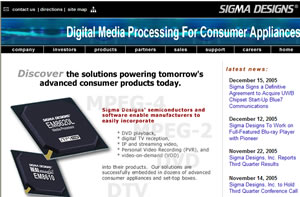 We’re sure you, dear reader, know what AJAX is, but just incase – it stands for Asynchronous JavaScript and XML. This translates to being able to use a Web browser more like a computer-based application.
We’re sure you, dear reader, know what AJAX is, but just incase – it stands for Asynchronous JavaScript and XML. This translates to being able to use a Web browser more like a computer-based application. The most often cited example is Google’s Gmail.
The most often cited example is Google’s Gmail. California based telecoms company, SureWest Communications, is set to become the first company in the USA to offer HDTV commercially over its Internet Protocol (IP)-based fibre-to-the-premise (FTTP) network.
California based telecoms company, SureWest Communications, is set to become the first company in the USA to offer HDTV commercially over its Internet Protocol (IP)-based fibre-to-the-premise (FTTP) network. “Through our HDTV channel lineup and launch of HDTV over IP, we are showcasing our dedication to providing customers with the highest-quality programming, sharpest picture available and a variety of emerging video products,” he added.
“Through our HDTV channel lineup and launch of HDTV over IP, we are showcasing our dedication to providing customers with the highest-quality programming, sharpest picture available and a variety of emerging video products,” he added. On HDNet, SureWest viewers can, err, thrill to original series like “HDNet World Report,” “Face 2 Face with Roy Firestone” and “HDNet Concert Series,” and if that lot doesn’t set you packing your bags for Sacramento, there’ll also be showing Warner’s “Smallville” series and a load of live sports productions include Major League Soccer games.
On HDNet, SureWest viewers can, err, thrill to original series like “HDNet World Report,” “Face 2 Face with Roy Firestone” and “HDNet Concert Series,” and if that lot doesn’t set you packing your bags for Sacramento, there’ll also be showing Warner’s “Smallville” series and a load of live sports productions include Major League Soccer games. The rollout of ADSL2+ in the UK appears to be going through a reverse-hype process, with people saying it’s not going to deliver high speeds to most people. That may be partially true, but in urban areas where people are within 1.5Km of the exchange they should get 20Mb/s+.
The rollout of ADSL2+ in the UK appears to be going through a reverse-hype process, with people saying it’s not going to deliver high speeds to most people. That may be partially true, but in urban areas where people are within 1.5Km of the exchange they should get 20Mb/s+. Following the BBC confirmation of High Definition Television (HD) trials for 2006, all of a sudden it feels like there’s a plethora of High Definition services and trials in the UK next year.
Following the BBC confirmation of High Definition Television (HD) trials for 2006, all of a sudden it feels like there’s a plethora of High Definition services and trials in the UK next year. Speaking at the same event, Richard Freudenstein, CEO, BSkyB, was careful not to mention what the monthly subscription will be for HD on Sky when it launches. He spent his time talking up the platforms’ HD bouquet that will include Sky One, sports and movies with an HD Sky Plus box and plenty of storage capacity.
Speaking at the same event, Richard Freudenstein, CEO, BSkyB, was careful not to mention what the monthly subscription will be for HD on Sky when it launches. He spent his time talking up the platforms’ HD bouquet that will include Sky One, sports and movies with an HD Sky Plus box and plenty of storage capacity. Confusion still reigns
Confusion still reigns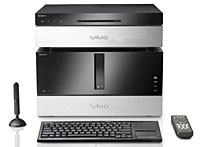 Sony are keen for us to ‘redefine’ our living rooms with the release of their new VAIO XL1 Digital Living System, a twin box offering combining a high-end multimedia PC with a 200-disc media changer/recorder.
Sony are keen for us to ‘redefine’ our living rooms with the release of their new VAIO XL1 Digital Living System, a twin box offering combining a high-end multimedia PC with a 200-disc media changer/recorder. A similar process takes place for movies, where an in-depth synopsis and star, cast, director and producer details etc are automatically downloaded and made accessible onscreen through the included wireless keyboard or remote control.
A similar process takes place for movies, where an in-depth synopsis and star, cast, director and producer details etc are automatically downloaded and made accessible onscreen through the included wireless keyboard or remote control. There’s no denying that the recording functionality seems mighty impressive to us, with the XL1 able to automatically and sequentially record up to 200 audio CDs from the media changer to the hard drive.
There’s no denying that the recording functionality seems mighty impressive to us, with the XL1 able to automatically and sequentially record up to 200 audio CDs from the media changer to the hard drive. To ensure that your late night listening pleasure isn’t spoilt by the sound of a mass of Boeing 747-like fans starting up, the XL1 system uses liquid-cooled components for quiet operation.
To ensure that your late night listening pleasure isn’t spoilt by the sound of a mass of Boeing 747-like fans starting up, the XL1 system uses liquid-cooled components for quiet operation. As the next-generation DVD wars between HD-DVD and Blu-ray Disc grind on, Paramount Home Entertainment has employed a time-honoured fudge and announced that it will be offering movies in both formats.
As the next-generation DVD wars between HD-DVD and Blu-ray Disc grind on, Paramount Home Entertainment has employed a time-honoured fudge and announced that it will be offering movies in both formats.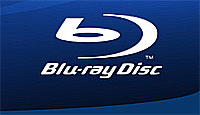 Paramount was one of the first major content players to back the Toshiba/NEC-developed HD-DVD format, with other major backers including Warner Home Video, HBO, New Line Cinema, Universal Pictures and Sanyo Electric, followed by Intel and Microsoft last week.
Paramount was one of the first major content players to back the Toshiba/NEC-developed HD-DVD format, with other major backers including Warner Home Video, HBO, New Line Cinema, Universal Pictures and Sanyo Electric, followed by Intel and Microsoft last week.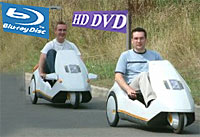 With Sony and Toshiba still enjoying a schoolyard scrap over which of their rival formats should become the standard format for next-generation DVDs, Samsung have announced a nifty compromise that plays both formats.
With Sony and Toshiba still enjoying a schoolyard scrap over which of their rival formats should become the standard format for next-generation DVDs, Samsung have announced a nifty compromise that plays both formats.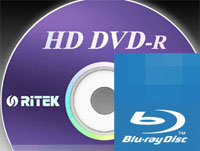 Although both Blu-Ray and HD DVD use groovy blue laser light to dramatically increase the storage capacity of a DVD-sized optical disc, they work in completely different ways.
Although both Blu-Ray and HD DVD use groovy blue laser light to dramatically increase the storage capacity of a DVD-sized optical disc, they work in completely different ways.